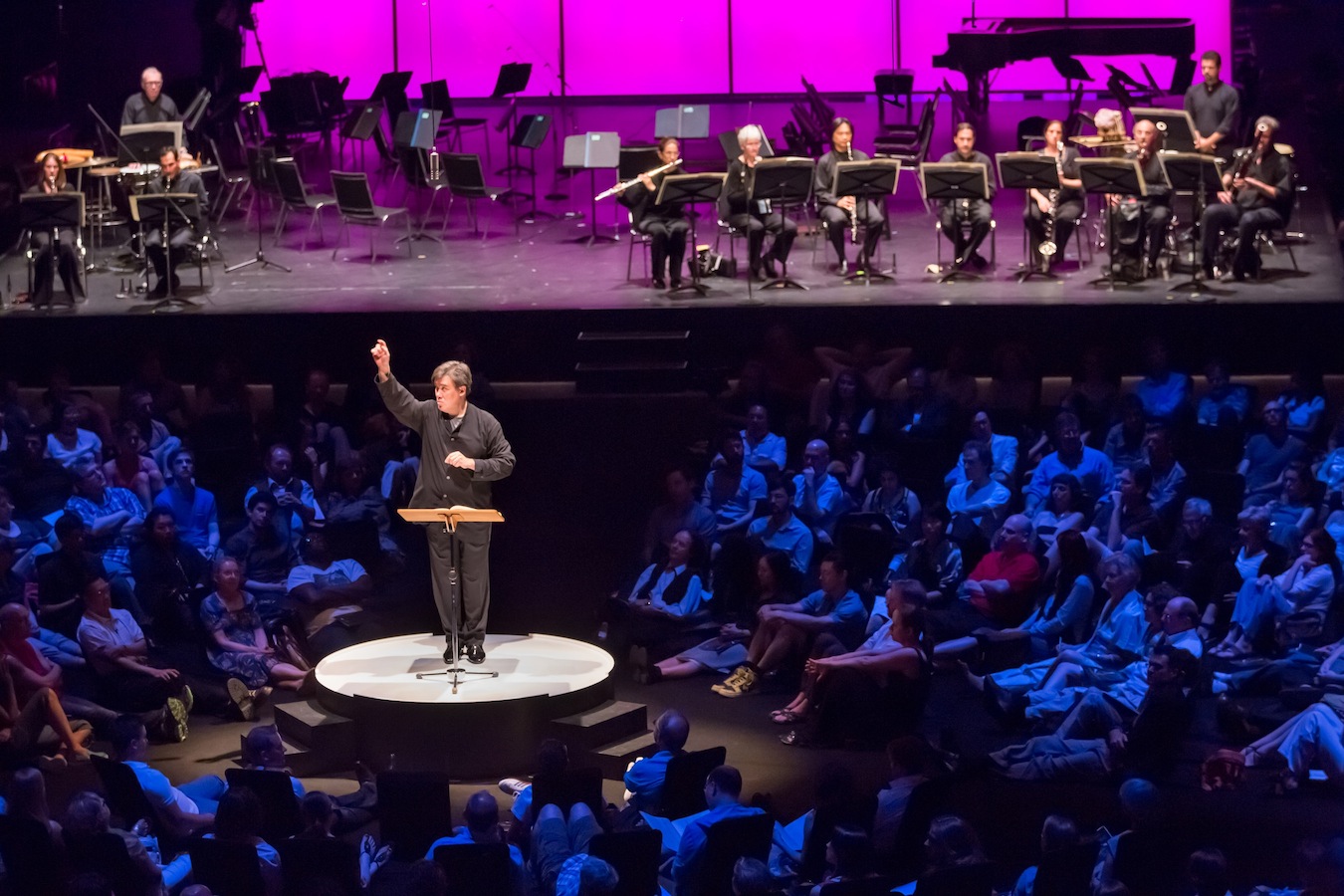New York Philharmonic closes season with an in-the-round modernist spectacular

Alan Gilbert conducts the New York Philharmonic in Boulez's "Rituel in memoriam Bruno Maderna" Friday night at the Park Avenue Armory. Photo: Chris Lee
It was a happy sight—at least for ticketholders and presenters: people of all ages and stripes, from hipsters to seniors, lined up outside the Park Avenue Armory on a steamy summer evening pleading for tickets to Friday evening’s sold-out “Philharmonic 360” concert by the New York Philharmonic.
Inside, the 55,000-square-foot Wade Thompson Drill Hall was configured for listening in the round, with a small group of concertgoers lounging on the floor in a circle in the middle of the hall. Behind them, along the room’s perimeter, tiered stands of seats alternated with performing spaces, each stage backed by milky illuminated panels. Balconies offered additional seating, standing room, and perches for musicians. The Armory’s elaborate iron beams brought to mind the industrial elegance of Paris’s Gare d’Orsay, with the blue and red mood lighting evoking a 1960s “happening.” The setting was both spectacular and fitting for a program centered on mid-twentieth-century works that grapple with cosmic concerns.
The floor seating had an historical precedent: during his tenure as the Philharmonic’s music director, Pierre Boulez introduced “Rug Concerts” as a way of attracting young listeners to classical concerts. Last night, the Philharmonic played his Rituel in memoriam Bruno Maderna, a work for orchestra in eight groups from 1974–75.
Polyphony is a primary element of the Rituel, and hearing its shimmering, color-drenched sounds unfold across a cavernous space was enthralling. Boulez is often labelled a forbidding composer, but as played by the Philharmonic, Rituel had all the luxuriant hues and textures characteristic of Messiaen (Boulez’s teacher) or Debussy. Quizzical phrases played by the reeds were answered by shrieking brass; the chthonic shimmer of gongs gave way to spiky but elegiac melodies.
Alan Gilbert presided over Rituel from a podium in the center of the hall. Karlheinz Stockhausen’s Gruppen for three orchestras (1955–57) required two additional conductors: Magnus Lindberg (composer-in-residence at the Philharmonic) and Matthias Pintscher. A sweet, trippy kind of fellow, Stockhausen claimed to hail from the dog star Sirius, and his Raummusik (“spatial music”) investigated the peculiar qualities of sound in space—including, in one case, music played from helicopters hovering over a concert hall.
Tense and demanding, Gruppen consists of 174 brief units of music based on 12-tone rows and bristling with percussion (ranging from ratchets and cow bells to xylorimbas and tam tams). On Friday evening, the audience received Gruppen rapturously, and for good reason. The Philharmonic’s playing was coruscating throughout, and the immersive experience thrilled the eyes as well as the mind and ears, as Gilbert, Lindberg, and Pintscher exchanged signals and glances in a kind of alertly coordinated dance. The orchestra threw pinpricks of light flying across the hall, summoned an eardrum-splitting explosion of percussion, sent forth a blizzard of jagged brass notes and electric guitar and sounded ominous gong tolls.
On the other hand, the Act I finale of Mozart’s Don Giovanni came off poorly. The valiant young vocalists—Ryan McKinny, Keith Miller, Julianna Di Giacomo, Russell Thomas, Keri Alkema, Sasha Cooke, and Kelly Markgraf—brought fire and panache to their portrayals, and all seemed to have lithe, fresh voices.
“Seemed,” alas, is the operative word, because the 55,000 square-foot space often swallowed up their singing. Its tricky echos and time lags also made for unremitting problems in synchronization between vocalists and orchestra and among instrumental ensembles—because Mozart layered a minuet, a contredanse, and a German dance in the finale primo of Don Giovanni. At the Armory what emerged was not artfully wrought disorder but just a murky sonic soup. When they could be heard, Miller’s sumptuous bass-baritone and Di Giacomo’s flamelike tones were especially impressive.
The program opened with an unannounced amuse-oreille: Canzon XVI, antiphonal brass music by Giovanni Gabrieli, whose works made breathtaking use of the unique acoustic in Venice’s Basilica of San Marco. The Philharmonic’s musicians played with stately grandeur, and you could feel physically, as a vibration, the sound waves from their gleaming instruments colliding in the middle of the hall and rippling back towards the perimeter, transformed and enriched.
The final offering was Charles Ives’ The Unanswered Question (1906), in which a trumpet intones, in the composer’s words, “The Perennial Question of Existence” against a wistful, shifting backdrop of slow string chords that seem as old as time itself and depict, again according to Ives, “The Silences of the Druids—Who Know, See, and Hear Nothing.” The Philharmonic never plays Ives less than brilliantly, and last night was no exception, with the composer’s unearthly sounds gliding seamlessly from the silence and darkness and returning to eternity—or nothingness—just as surreptitiously.
Bookending the concert with Gabrieli and Ives was a canny choice. Gabrieli wrote centuries ago for the greater glory of an unseen, providential deity; Ives, writing after Nietzsche proclaimed God’s death, evoked an impassive cosmos. The Venetian wrote for a resplendent place of worship, and the Yankee for a secular space where equally great mysteries are pondered in a spirit of incomprehension and doubt: the modern concert hall.
Like the Philharmonic 360 program as a whole, the juxtaposition really made you think.
The Philharmonic 360 program repeats 8 p.m. Saturday at the Park Avenue Armory. The concert will be webcast at nyphil.org starting July 6. 212-875-5656.

Photo: Chris Lee
Posted Jul 01, 2012 at 9:44 am by Jorge Suarez-Velez
I totally agree with this review. For me, it was a truly memorable concert that took me beyond my zone of comfort to a point where I just let my senses go, and enjoyed every second of the experience. I had never fully realized the power of space in music. While the Met has become two-dimensional due to performances screened on theaters around the world, it was a joy to be part of such a spatial and extraordinary concert, reclaiming the pleasure of live performance.